[orc]Year after year, there is discrepancy between the data on communal incidents reported by the Home Ministry & the NCRB. In this story, we look the numbers, the discrepancies and the way forward.
After a delay of 1.5 years, the National Crime Records Bureau (NCRB) has recently published Crime in India-2017 report. The report furnishes the statistics of the various crimes committed in India during 2017. This annual report from NCRB acts as the main reference as far as the crime statistics in India are concerned.
Over the past few years, the debate over communal incidents in the country hasn’t stopped. While political parties and groups trade charges over one another, we look at the state of data related to communal incidents in the country and if the past discrepancies have been corrected in 2017. Multiple times in the past, Factly has written about such discrepancies and how the data from NCRB did not match with the data from the Home Ministry.
NCRB reports 723 riots of Communal nature in 2017
As per NCRB’s Crime in India -2017 report, the number of riots of communal/religious nature was 723 for the year 2017. Since 2014, the riots of communal/religious nature are being reported separately. Prior to that, NCRB’s crime in India categorized any riots under one larger head ‘Riots’, which also included Industrial, Political, sectarian, caste related etc. among others.
Over this 4-year period, since the NCRB report has been categorizing the communal/religious riots separately, 2017 reported the least number of such incidents. As per NCRB’s data, the highest number of such riots were reported in the year 2014 (1227 incidents).
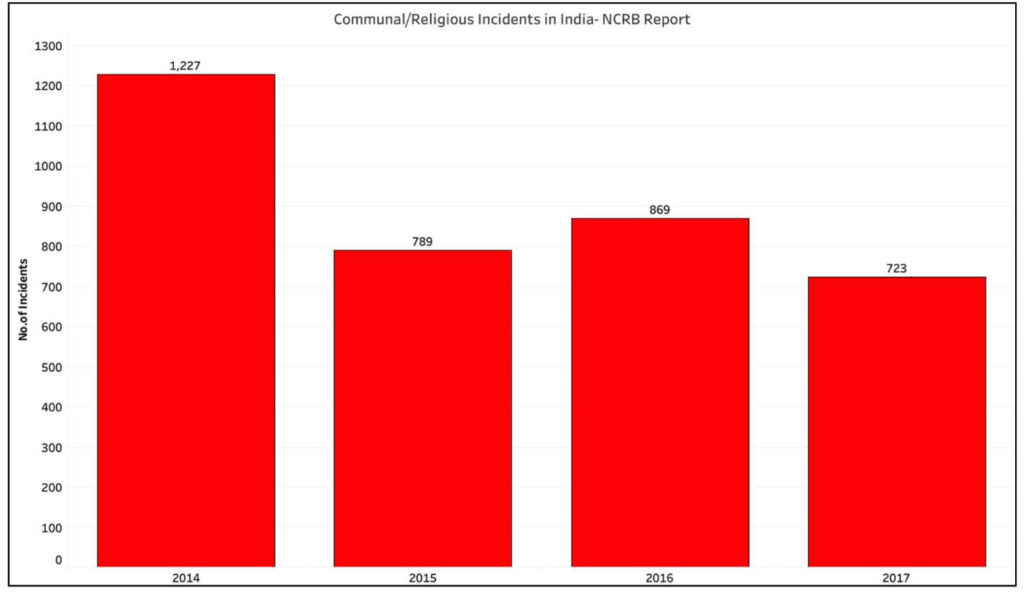
Bihar reported the highest such riots followed by Karnataka and Odisha.
Of the 723 incidents such riots of communal nature in the country as per NCRB report, 163 are from Bihar. Karnataka and Odisha rank next with 92 and 91 incidents respectively. Maharashtra with 71 incidents and Jharkhand with 66 incidents complete the top 5 states with the highest incidents of communal/religious riots in 2017. Goa, Himachal Pradesh, Punjab, Uttarakhand along all the North-Eastern states and all the Union Territories have reported zero Communal/Religious riots in 2017.
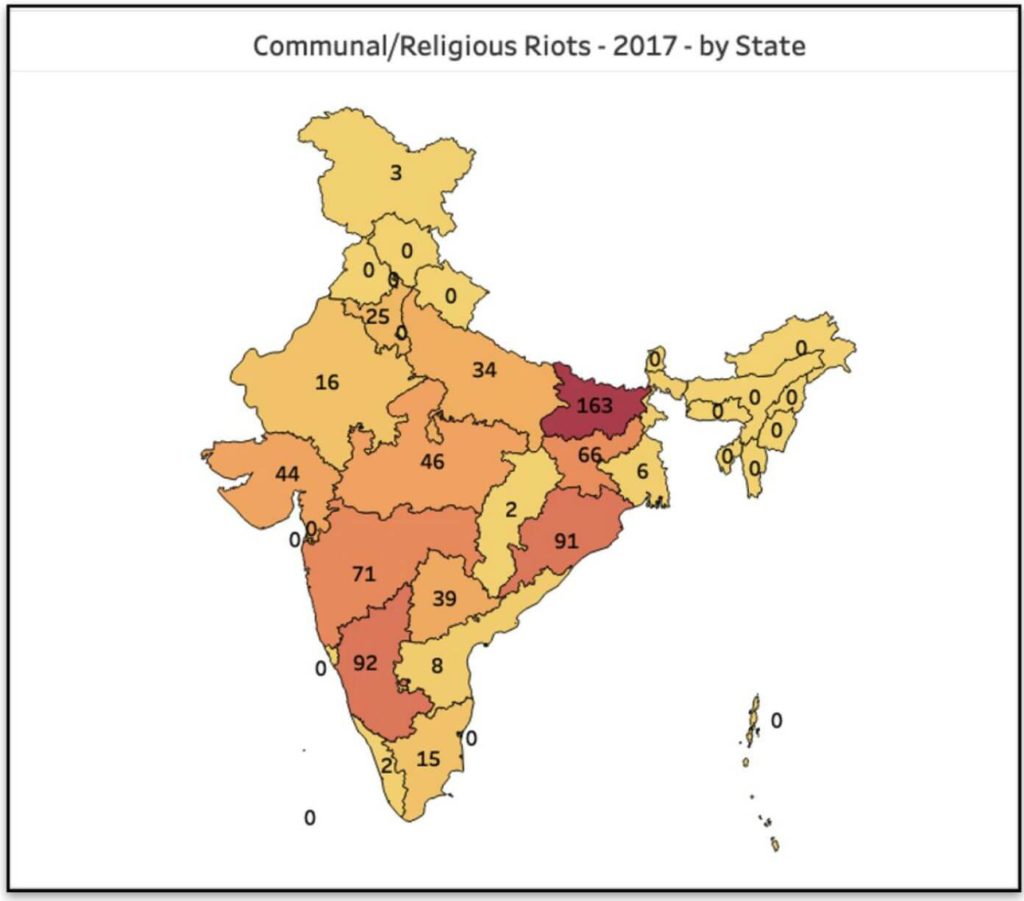
In 2016, Haryana with 250 such incidents reported the highest number of communal/religious riots followed by Jharkhand (176), Bihar (139), Maharashtra (57) and Karnataka (42). While the overall such incidents fell down from 869 in 2016 to 723 in 2017, the number of states which reported an increase in the number of such riots compared to 2016, has gone up. The overall dip in the national figure was due to the fall in the numbers for Haryana and Jharkhand in 2017.
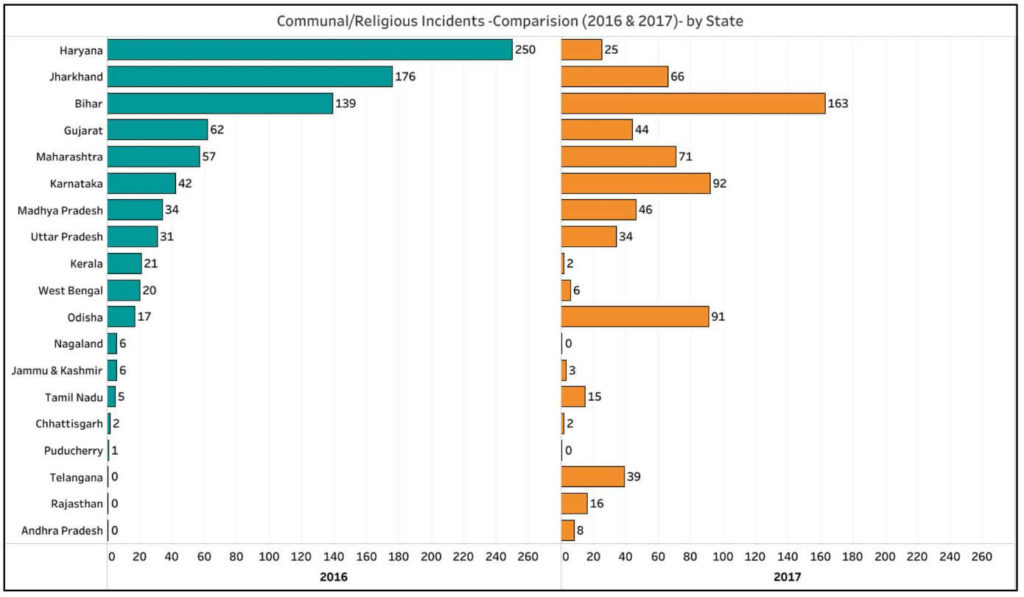
Number of instances higher in 2017 according to the information provided by the Home Ministry
As per the data provided in response to a question in Lok Sabha on 06 February 2018, by the Ministry of Home Affairs (MHA) , the number of Communal incidents recorded for 2017 was 822. The Information provided by Home Ministry in Lok Sabha, also differs from the NCRB numbers in the earlier years.
If one compares the data for the four years (2014, 2015,2016,2017) where in NCRB report has specifically categorized ‘Communal/Religious’ riots, reveals that there is a difference between the NCRB data and the information provided by the Home Ministry every year. The number of incidents reported by Home Ministry in Lok Sabha for 2014, 2015, 2016 are 644, 751 and 703 respectively. In fact, this is the first time in these 4 years when the MHA reported higher numbers compared to the NCRB.
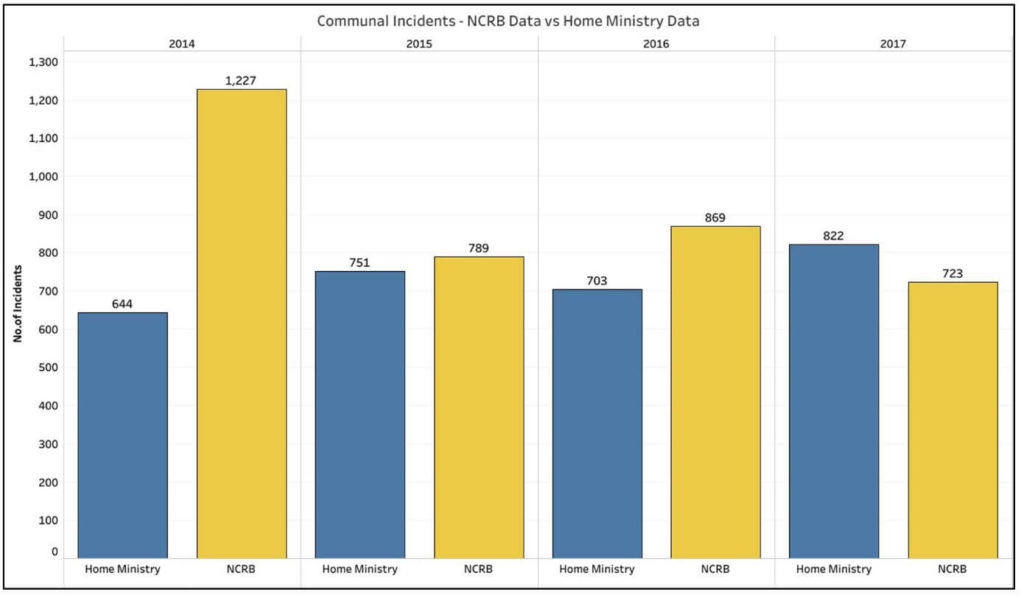
Large State wise variance between NCRB and Home Ministry Data
A larger variance exists when the state wise data provided by NCRB and Home Ministry is compared.
It was noted earlier that as per NCRB data, Bihar reported the highest number of incidents for 2017 with 163. However as per the data provided by MHA in Lok Sabha, Uttar Pradesh leads the list with 195 incidents. As per NCRB data, Uttar Pradesh had only 34 instances of communal riots.
Rajasthan also have large variance between NCRB data and MHA’s data. In the former, the reported incidents for 2017 were only 16, while in later it is 91. Odisha is another state with a large difference between the two sources of Information with NCRB data reporting 91 instances and the MHA’s data reporting only 4 instances. In the case of West Bengal also, only 6 incidents were reported by NCRB, while as per MHA’s data provided in Lok Sabha, the number of communal incidents were 58.
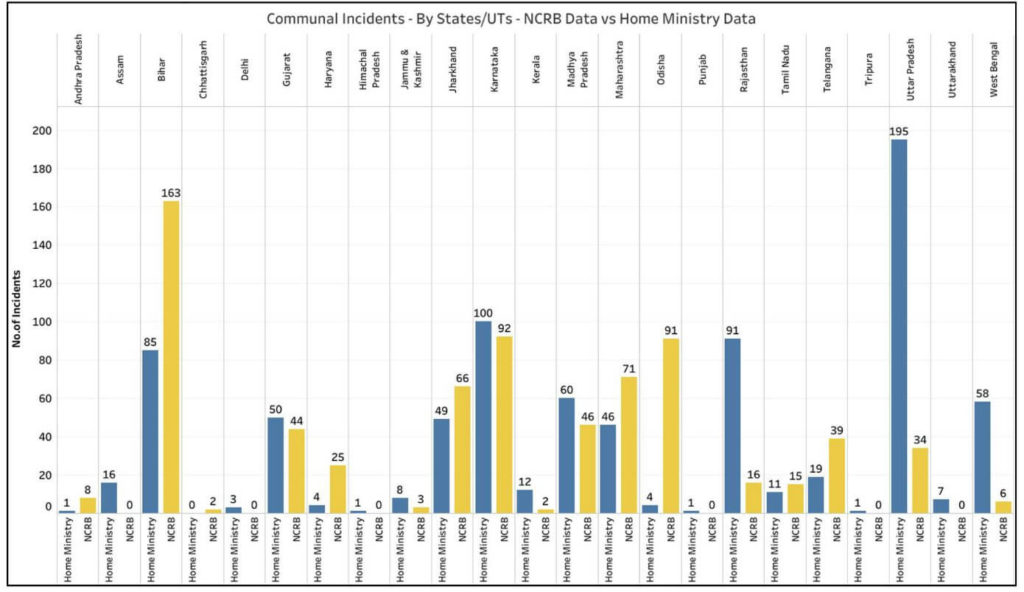
2008 had the highest number of communal incidents in 10 years as per MHA
If one compares the data provided by the MHA for the last 10 years, the year 2008 had the highest number of communal incidents with 943 as per information provided in the Lok Sabha.
The next highest as per MHA was 823 incidents in 2013 followed by 2017 with 822 incidents.
However as per NCRB report, 1227 communal riot incidents were reported in 2014 which is higher than the highest number of incidents reported by Home Ministry over the last decade.
As per Home Ministry’s data, the number of such incidents recorded have reduced over the next three years after the high of 2008. After the lowest number of communal incidents (580) recorded in 2011, the number of incidents has fluctuated over the last few years.
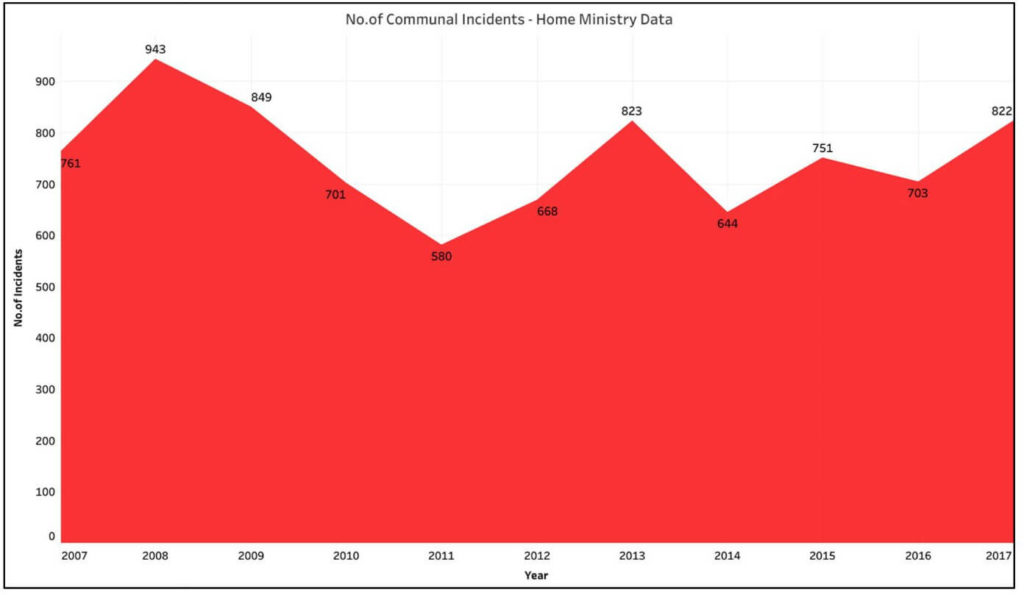
Is there an explanation such large variance between the data of NCRB & MHA?
If one looks at the definition of what constitutes a riot in the NCRB data, both in 2016 & 2017 report of the NCRB, riots were categorized as those crimes recorded under sections 147 to 151 of the Indian Penal Code (IPC). Apart from riots of communal/religious nature, there is another set of information provided in the NCRB Report, ’Promoting enmity between groups (Sec.153A & 153B IPC)’. Section 153 A of Indian Penal Code (IPC), deals with incidents promoting enmity between different groups based on religion, race, place of birth etc. The number of crimes under this section are reported separately.
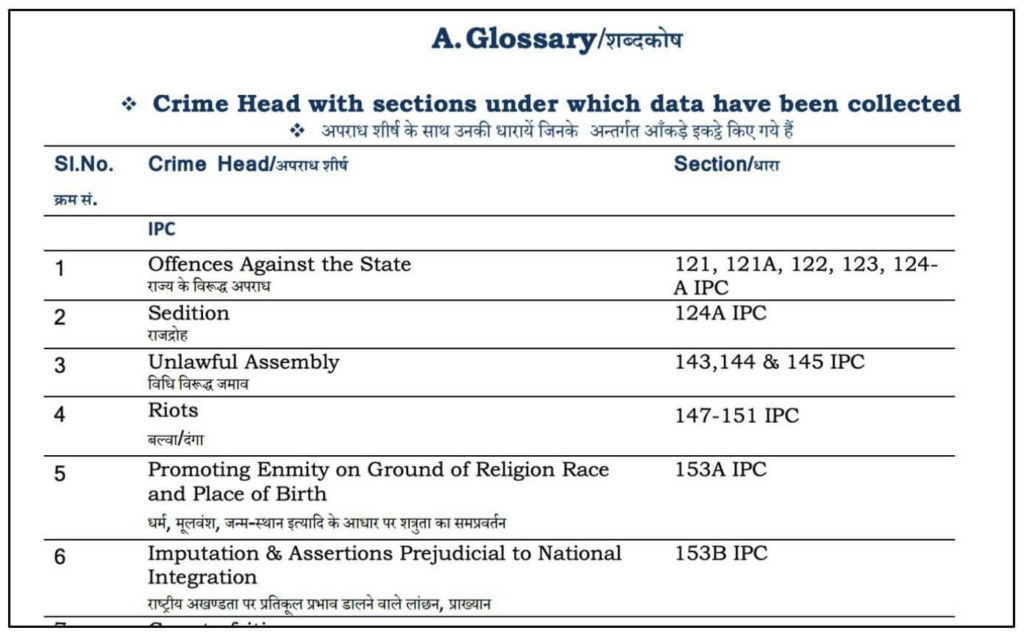
If one adds the numbers reported under riots as well as those reported under Sec 153A of the IPC, the difference between the NCRB data and the MHA data would further increase.
The MHA data is collected from state governments and the intelligence bureau. Incidentally, the NCRB also functions under the Home Ministry. NCRB comes under the aegis of Ministry of Home Affairs and is tasked to function as a repository of information on crime and criminals. The data for the annual Crime in India report is based on the information furnished by the law enforcing departments at State/UT level. Furthermore, the data reported follows the ‘Principal Offence Rule’, in which the most heinous of the crime (maximum punishment), is considered for counting, even though there could be multiple offences reported in the First Information Report (FIR).
For example, an instance of communal riot which leads to murder would be counted as ‘Murder’ case as it the most heinous of the crimes reported in the FIR. This could result in under reporting in few instances wherein a case is not registered as a communal riot. This partially explains the scenario for those stats where in the NCRB data reports fewer communal riot instances compared to the data that the Ministry provides in the parliament.
However, since NCRB data is dependent on the FIRs, there could be occasions where multiple FIRs are registered for a single communal incident by opposing parties. This could result in the number of communal incidents reported being higher in the NCRB data compared to the actual incidents as per Home Ministry.
Another scenario could be a case for non-filing of a FIR even though an incident has taken place. This could result in fewer numbers being reported by the NCRB. For example, Uttar Pradesh has 195 communal incidents in 2017 as per Home Ministry’s information, but NCRB data shows only 34. While we cannot ascertain if it is because of not filing FIRs or the cases being counted for another crime, it reflects large variance. The NCRB also captures communal/religious motive for murder. In the case of Uttar Pradesh in 2017, only one case was reported to have a communal/religious motive for murder. Adding these numbers up also does not explain the large discrepancy between the two sets of data.
Since NCRB is under aegis of Home Ministry, a process which to reconcile the differences of the data has to be established to get the real picture of not only the number of incidents occurring but also the incidents which the law enforcing authorities have taken cognizance of through filing a FIR. Such discrepancies year after year undermine the sanctity of data and the institution.
Unless there is a reform in the way crime reporting & data collation is done, as noted by Factly earlier, these discrepancies are here to stay.



2 Comments
Pingback: Part 1: What does the NCRB report tell us about the State of Crimes in India? - Fact Checking Tools | Factbase.us
Pingback: Part 2: Does NCRB crime data present an accurate picture of crime on ground? - Fact Checking Tools | Factbase.us